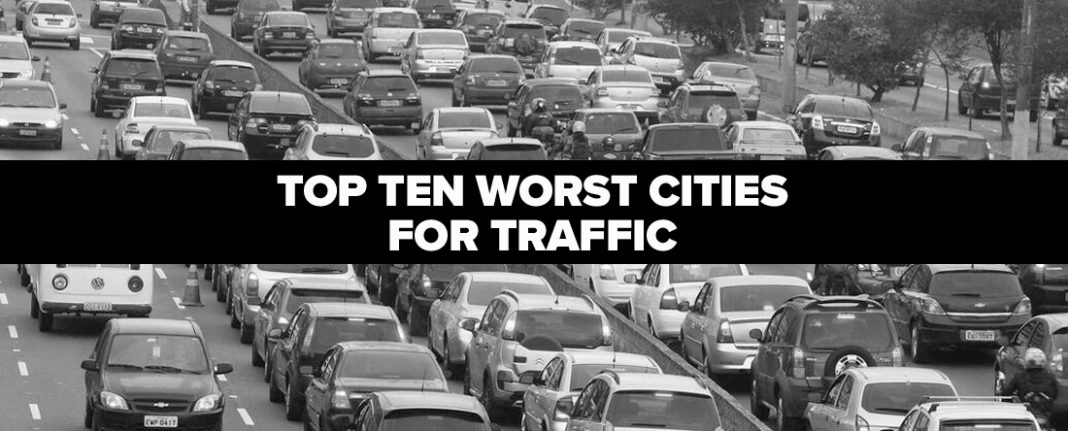Report: Miami Has 10th-Worst Traffic in the World
If it feels as if you are spending a lot of time stuck in Miami traffic, your perceptions are accurate.
A recent report from INRIX ranked Miami as having the fifth-worst traffic of all U.S. cities and the 10th-worst in the world. Miami drivers spent 64 hours on congested roads in 2017. According to the report, that translates to 9 percent of driving time spent waiting in traffic.
According to INRIX, this congestion cost U.S. drivers almost $305 billion in 2017. The average American driver pays $1,445 because of increased traffic. Those costs include the amount of time and fuel traffic wastes, as well as indirect costs of idling freight and business vehicles that companies pass on to consumers.
Which Cities Have Worse Traffic Than Miami?
Globally, only nine cities in the world have worse traffic than Miami:
1. Los Angeles, CA
2. Moscow, Russia
3. New York City, NY
4. São Paulo, Brazil
5. San Francisco, CA
6. Bogotá, Colombia
7. London, UK
8. Atlanta, GA
9. Paris, France
10. Miami, FL
Why Is Our Traffic Congested? INRIX blames U.S. highway congestion on several factors. Americans are driving more miles a year. Though more drivers are on the roads and are traveling more miles than ever, our road infrastructure has not kept pace. That means many roads can no longer support the number of drivers that travel them daily.
Because our vehicles are now more fuel-efficient, gas taxes have lost their value. That decrease in spending power, combined with inflationary pressure, has taken a toll on traditional sources of funding for highway construction and maintenance. Because American metropolitan areas tend to cover a larger geographic footprint than European cities, public transportation is seldom a viable alternative to driving a personal vehicle.
A recent Miami New Times article blames the worsening of our congestion on a lack of urban planning that would improve public transportation in areas with the densest population. As the city’s population continues to grow, these traffic problems are likely to continue.
Why Does Traffic Congestion Matter?
Being stuck in a traffic jam is not only an unpleasant experience, it can also lead to road rage, unsafe driving, and more car accidents.
People tend to tailgate in traffic, following too closely behind the vehicle in front of them. This can increase the chances of a rear-end collision. People may also look at their cell phones or engage in other distractions when stuck in stop-and-go traffic. They may make a call and let someone know they will be late, pull up a navigation app to search for an alternate route, or check their emails and social media while they wait. This can lead to a distracted driving crash if traffic begins to move unexpectedly.
Miami, FL has some of the worst traffic in the nation. Between residents, domestic and international tourists, and commuters, its roads are jam-packed from sunrise to sundown. Unfortunately, it’s hard for drivers to get around Miami safely. More car accidents are reported in Miami-Dade County than anywhere else in the state.
Why do car accidents happen so frequently in Miami?
According to Boris Lavent, a Miami car accident lawyer, “Several factors contribute to the problem. However, studies have shown that poor road conditions and dangerous driving behaviors are at the root of the problem.”
Motorists, bicyclists, and pedestrians will continue to get hurt until Miami addresses these issues. Lawmakers and city officials have acknowledged that there’s a lot of work to do. Fortunately, the city has also taken steps to make its roads safer.
Recent Surge in Car Accidents Across Miami, FL Traffic accidents have always been problematic in Miami. However, the rate at which drivers are getting into collisions has increased significantly in recent years.
In 2014, there were 60,191 car accidents in Miami. By 2017, there were 65,986 reported collisions in the city. That’s an increase of nearly 10 percent in just four short years. More recent statistics indicate that this trend is continuing.
Safety Concerns Regarding Miami Roads and Infrastructure If roads are in poor condition, it’s difficult for drivers, pedestrians, and bicyclists to get from one place to another safely. Unfortunately, there are several safety concerns regarding Miami’s existing roads and infrastructure. These concerns are highlighted in infrastructure safety reports published by independent organizations.
The American Society of Civil Engineers Report
Every few years, the American Society of Civil Engineers (ASCE) publishes an analysis of road conditions in the United States. In its most recent report, infrastructure in Florida received a “C” average. The low grade is due, in part, to crumbling infrastructure in its most heavily-populated cities, including Miami.
According to the ASCE report:
Florida is growing, but its roads and highways are not keeping pace. In the past 30 years, the number of miles logged on Florida roads has increased by 84 percent, but highways have only been expanded by 25 percent.
Florida communities are not spending enough money to keep its roads, bridges, and infrastructure in safe operating condition. Cities like Miami are underfunding essential road improvement projects.
Traffic and congestion cost Miami drivers an average of $1,000 every year.
The state of Florida has more than 122,000 miles of public roads and highways. The ASCE determined that 9 percent of those roads, including many in urban areas like Miami, are in poor condition.
Best & Worst Cities to Drive
A study published by Wallethub rated the best and worst cities to drive in the United States. The study analyzed several factors, including (a) traffic and infrastructure and (b) safety. Miami ranked near the bottom in both of these categories.
Traffic & Infrastructure: Miami ranked 84th out of 100 cities Safety: 90th out of 100 cities Why did Miami rank so poorly? The city’s dangerous intersections and pothole problems were likely key considerations.
Intersections in Miami Miami has some of the most dangerous intersections in the state of Florida. Many of the most violent and devastating accidents in the city happen at or near these intersections. Intersections in Miami tend to be particularly dangerous because they’re not designed to accommodate heavy traffic. As congestion increases in Miami, so do the number of accidents at these crossroads.
Miami’s Pothole Problem Generally speaking, Florida’s roads are in fairly good condition. The same can’t be said for congested urban areas like Miami. Drivers frequently complain about road conditions. One of the biggest complaints is the number of potholes on city roads. Potholes can be hard to avoid, cause extensive vehicle damage, and contribute to a significant number of collisions.
Miami knows that its roads aren’t in great condition. It also knows that these hazardous road conditions are contributing to a staggering number of traffic accidents every year. In recent years, lawmakers and officials have taken steps to embrace initiatives to make city roads and highways safer.
Vision Zero: Miami recently launched a Vision Zero initiative, which aims to eliminate traffic deaths and injuries in the city by 2030. Exhaustive studies have been conducted to (a) pinpoint the leading causes of severe accidents and (b) identify solutions. The initiative focuses on three distinct areas: engineering, enforcement, and education. Miami has pledged to fund improvements to infrastructure, strengthen traffic safety laws, and advance motorist safety education programs.
Bike305: Bicyclists and pedestrians face tough conditions on Miami roads. Infrastructure was designed to accommodate high-speed traffic, not alternative modes of transportation. In order to reduce the number of bicycle accidents across the city, officials launched an initiative called Bike305. The program encourages residents and tourists to take advantage of 27 miles of dedicated bicycle and pedestrian infrastructure.
Mass Transit: Miami’s roads are crowded and they’re only getting worse. The city has funded programs to expand and improve upon its mass transit systems. Public transportation can relieve some of the congestion on Miami and help to reduce accidents across the city.










![– [ ] ☎️CALL NOW!! ????????
– [ ] (786)650-9456 #ydiaztowing
– [ ] ????Best Towing Service in Miami????
– [ ] .
– [ ] .
– [ ] .
…](https://www.miamicars.com/wp-content/uploads/2024/04/439880935_17874044664082011_820307467258220909_n-100x70.jpg)



![– [ ] ☎️CALL NOW!! ????????
– [ ] (786)650-9456 #ydiaztowing
– [ ] ????Best Towing Service in Miami????
– [ ] .
– [ ] .
– [ ] .
…](https://www.miamicars.com/wp-content/uploads/2024/04/439880935_17874044664082011_820307467258220909_n-324x160.jpg)

